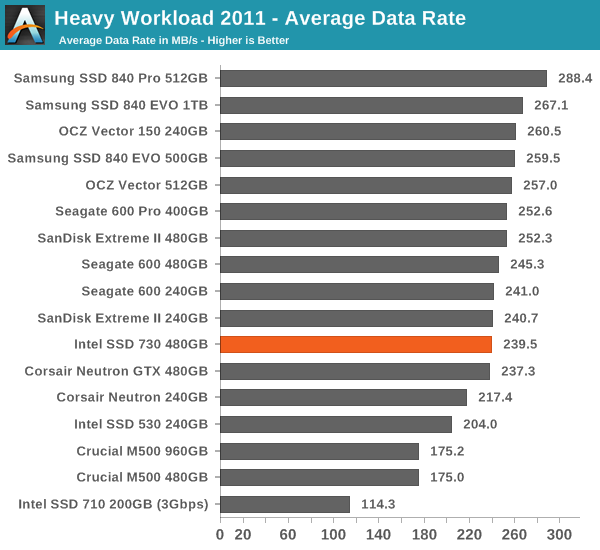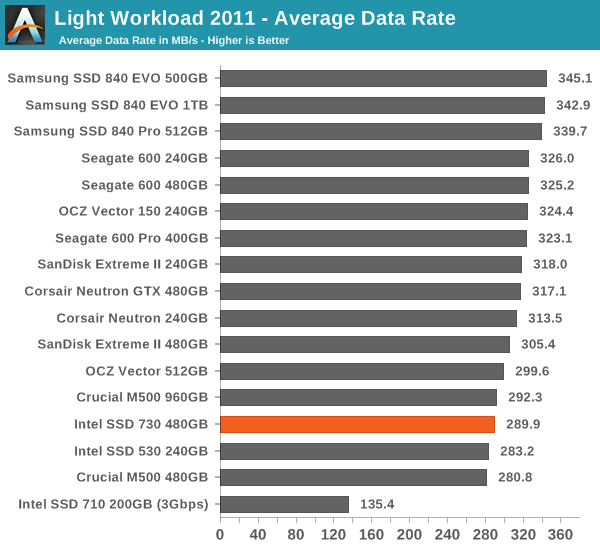Intel SSD 730 (480GB) Review: Bringing Enterprise to the Consumers
by Kristian Vättö on February 27, 2014 12:00 PM EST- Posted in
- Storage
- SSDs
- Intel
- Intel SSD 730
AnandTech Storage Bench 2011
Back in 2011 (which seems like so long ago now!), we introduced our AnandTech Storage Bench, a suite of benchmarks that took traces of real OS/application usage and played them back in a repeatable manner. The MOASB, officially called AnandTech Storage Bench 2011 - Heavy Workload, mainly focuses on peak IO performance and basic garbage collection routines. There is a lot of downloading and application installing that happens during the course of this test. Our thinking was that it's during application installs, file copies, downloading and multitasking with all of this that you can really notice performance differences between drives.
We tried to cover as many bases as possible with the software incorporated into this test. There's a lot of photo editing in Photoshop, HTML editing in Dreamweaver, web browsing, game playing/level loading (Starcraft II & WoW are both a part of the test) as well as general use stuff (application installing, virus scanning). We've included a large amount of email downloading, document creation and editing as well. To top it all off we even use Visual Studio 2008 to build Chromium during the test.
The test has 2,168,893 read operations and 1,783,447 write operations. The IO breakdown is as follows:
| AnandTech Storage Bench 2011 - Heavy Workload IO Breakdown | ||||
| IO Size | % of Total | |||
| 4KB | 28% | |||
| 16KB | 10% | |||
| 32KB | 10% | |||
| 64KB | 4% | |||
Only 42% of all operations are sequential, the rest range from pseudo to fully random (with most falling in the pseudo-random category). Average queue depth is 4.625 IOs, with 59% of operations taking place in an IO queue of 1. The full description of the test can be found here.
AnandTech Storage Bench 2011 - Heavy Workload

AnandTech Storage Bench 2011 - Light Workload
Our light workload actually has more write operations than read operations. The split is as follows: 372,630 reads and 459,709 writes. The relatively close read/write ratio does better mimic a typical light workload (although even lighter workloads would be far more read centric). There's lots of web browsing, photo editing (but with a greater focus on photo consumption), video playback as well as some application installs and gaming.
The I/O breakdown is similar to the heavy workload at small IOs, however you'll notice that there are far fewer large IO transfers.
| AnandTech Storage Bench 2011 - Light Workload IO Breakdown | ||||
| IO Size | % of Total | |||
| 4KB | 27% | |||
| 16KB | 8% | |||
| 32KB | 6% | |||
| 64KB | 5% | |||

Again, the SSD 730 comes up with relatively uninspiring performance in this lighter, older workload. If your usage patterns are relatively tame, a drive designed for enterprise usage scenarios may be more than you need and may actually end up performing slower than "lesser" drives in day-to-day use—not that you'd likely notice, as most decent SSDs are now at the point where to normal users they're all plenty fast.










96 Comments
View All Comments
emn13 - Sunday, March 2, 2014 - link
It's interesting to note that both Crucial's M500 and intel's 730 have power-loss protection and a fairly high idle power. Does power-loss protection imply a high idle power?Kristian Vättö - Sunday, March 2, 2014 - link
The M500 supports low-power states (HIPM+DIPM) so in a mobile environment the power consumption is much lower: http://www.anandtech.com/bench/SSD/732hojnikb - Wednesday, March 5, 2014 - link
Is this related to devsleep or do older chipsets support that kind of low power consumption aswell ?Because in some reviews, m500 has quite high idle power consumption...
Kristian Vättö - Wednesday, March 5, 2014 - link
This isn't DevSleep, it lower the idle power consumption even more. This is just HIPM+DIPM (Host/Device Initiated Link Power Management), which is supported by older chipsets as well. However, note that only mobile chipsets support HIPM+DIPM, which is why the power consumption is significantly higher when tested in a desktop environment (like most reviewers do).amddude10 - Friday, November 28, 2014 - link
The power loss protection in crucial drives like the m500 is supposedly very incomplete, and not nearly as good as it is with the 730, or in enterprise drives, so its comparing apples and oranges. I would however say that SSD's which are going to be used in laptops are in much less need of power loss protection, but more in need of low power consumption, whereas SSD's that are intended for desktop use don't need low power consumption, and are in much higher need of power loss protection.CeceliaAFolger - Sunday, March 2, 2014 - link
hywoolfe9998 - Sunday, March 2, 2014 - link
This doesn't strike me as an especially impressive product given what is already out there. Frankly, it seems that SSD technology has settled to the point where the only thing that matters any more is price/capacity. Find me half TB SSD for $200 and I'll care.hojnikb - Wednesday, March 5, 2014 - link
U can get m500 480GB for ~250$ or less if u find a deal. Thats pretty cheap, if you ask me..RAYBOYD44 - Monday, March 3, 2014 - link
til I looked at the receipt for $5432 , I accept that...my... cousin had been truley bringing home money part-time on there computar. . there aunts neighbour had bean doing this for only about 1 year and just paid for the mortgage on their home and purchased BMW M3 .Neo Zuko - Monday, March 3, 2014 - link
I was a big fan of the Sata II Intel SSDs but for Sata III I switched to the Samsung 830 Pro and then the Samsung 840 Pro as my SSD of choice. Seems it's time change up again to the SanDisk Extreme II (which was mentioned to be the new favorite SSD) and or the Intel 730 here.However the Intel 730, for all it does well, does not seem to be completely optimized for the average home PC workload and the top performance is suffering. And you can't use it in a laptop. These seem to be big deal breakers to me. Given those limitations it seems the SanDisk Extreme II would still be Anandtech's favorite SSD. Did I get that right? And would the SanDisk Extreme II work well in a PS4 without trim? And as an aside, I would not mind a better paragraph as to why the SanDisk is a favorite. Is it the near Intel constancy combined with the fast performance - like a best of both worlds thing? Also when is SanDisk releasing that enterprise lite version of the Extreme II with power failure features?